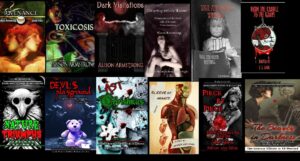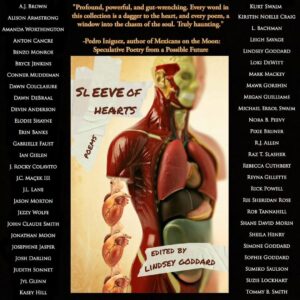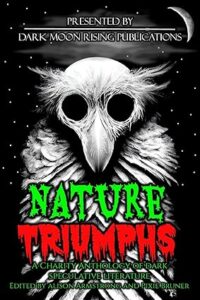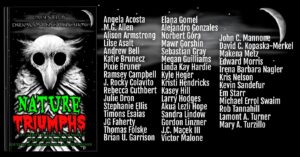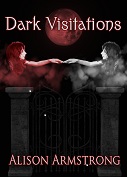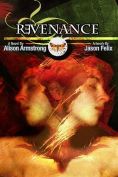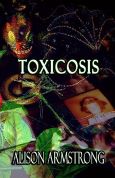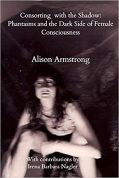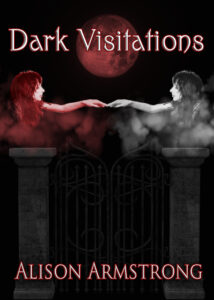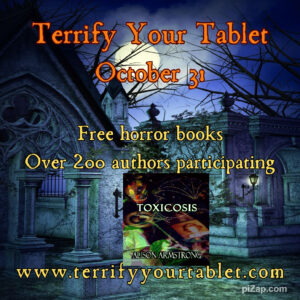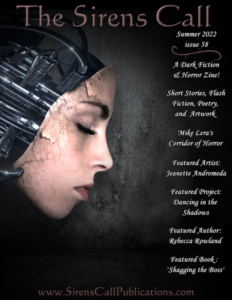Collage with all of my books, including anthologies with my writings so far. Most of these books are available on Amazon and other online retailers.
ANNOUNCEMENT: Since I have a Substack account for my writings, I will be discontinuing my newsletter and associated mailing list shortly. For news and posts regarding my writings, you can subscribe for free to my Substack:
https://armstronga.substack.com/
New video trailer I created for my vampire novel Revenance, Book 1 of the Feral Rebirth series:
UPDATE: May 1, 2025
I’m happy to have my books Revenance, Toxicosis, Dark Visitations, and Consorting with the Shadow: Phantasms and the Dark Side of Consciousness available now in The Edith Garland Depre Library, University of Louisiana at Lafayette as part of its Women in Horror collection.
SCREAM FOR BOOKS – WOMEN IN HORROR BOOK DRIVE
UPDATE: Feb. 20, 2025
My short story “Fungal” has been included in The Beauty in Darkness: The Literary Tribute to T.S. Woolard anthology, available on Amazon and other online retailers.
UPDATE: Feb. 17, 2025
My short story “The Question” and author bio are included in the SKG Author Services Women in Horror blog:
UPDATE: Feb. 12, 2025
My poem “Bitch Queen Beatrice” and my short story “Adrift” have been included in the newly released Piece by Piece anthology, available on Amazon.
UPDATE: Jan. 20, 2025
My poem “Fear” has been included in the newly released “Sleeve of Hearts” poetry anthology, available on Amazon, Lulu.com, and Barnes and Noble.
UPDATE: Dec. 18, 2024:
Last Christmas: A Holiday Horror Anthology is now available in digital and paperback formats at Amazon and other online retailers. The anthology includes my short story “The Red Birds.”
UPDATE: Dec. 11, 2024:
The Devil’s Plaground: A Horror Charity Anthology for Drug Addiction (available at Amazon and other online retailers) includes my poem “Moribund Feast”.
UPDATE: Sept. 3, 2024
Nature Triumphs: A Charity Anthology of Dark Speculative Literature-edited by Alison Armstrong and Pixie Bruner, published by Dark Moon Rising Publications. Available at Amazon in Kindle and paperback versions.
Also available at Books2Read
A dark speculative fiction anthology of ecological delights and nightmares. In each piece, Nature prevails, it triumphs, one way or another, with teeth, claws, vines, tentacles, or more over human exploitation. Prose and poetry are equals here, giving you decadent, violent, and elegant delights. Dark humor and dark tales for dreams of a better tomorrow. All speculative subgenres are included, from literary horror, extreme horror, psychological horror to dark science fiction and new weird. Beloved authors of horror, science fiction and new voices all raised in a cautionary chorus for ecological awareness. Life must always find a way.
All proceeds go to The Nature Conservancy.
Excerpts from some of the reviews of Nature Triumphs on Amazon:
My books available in digital and print format:
Links are to my books available via Book2Read retailers (left) and Amazon (right)
All of the writings on this page are by Alison Armstrong
My bio:
Alison Armstrong is the author of two literary horror novels (Revenance and Toxicosis), a novella (Vigil and Other Writings), and a collection of writings addressing women and horror archetypes (Consorting with the Shadow: Phantasms and the Dark Side of Female Consciousness). Her work focuses on inner terror, stealthily lurking, solipsistic dread and nightmare flash epiphanies. Having obtained a Master of Arts in English, she has taught composition and literature at Washtenaw Community College in Ann Arbor, MI and Kingsborough Community College in Brooklyn. In addition to her novels and novella (available on Amazon), she has had writings published in The Sirens Call and the horror anthology Book of Bones. Further information on her writings is available on her Web site, https://horrorvacui.us/ , and on her Facebook page for the novels Revenance and Toxicosis .
Reviews for my book Dark Visitations:
“Her best yet — riveting! A deep, dark, and delicious read. Very moving –this novel really bowled me over. In beautifully written, compelling, highly readable prose, a likeable and empathetic voice chronicles the childhood and later life experiences that lead Alley into becoming a vampire. . . .”
“This novel poignantly depicts deep and intimate experiences . . Alison Armstrong’s latest novel, “Dark Visitations,” succeeds not only as a stand-alone work but also as part of her “Feral Rebirth” series. . . . It is a living elucidation of key themes we struggle with as a species and as a society: memory, childhood and adolescence and young adulthood, mortality, spirituality, sex roles, family relationships, the role of nature in our lives. On its third and most valuable level, it is a depiction of deep and intimate experiences: what one sees in the darkness before falling asleep, how one hears and interprets a cat fight outside one’s window, what one feels looking into an open medicine cabinet full of medicines that can as easily kill a person as temporarily relieve her physical pain.”
Lushly dark coming-of-age story with a relatable narrator. . . . I haven’t read the rest of the series yet, but this prequel novel is capable of standing alone as a lushly dark coming-of-age story about a girl who never fit in with the others. As one of those girls myself, the narrator REALLY resonated for me, and she will for you too, if you were a kid who always gravitated to the darker things in life. . . . The writing style is rich and verges on purple in the best of ways. It’s reminiscent of early Anne Rice novels. The supernatural entities who visit our protagonist are deliciously spooky. And, as a lover of vampires, I loved that this ends up being the opener to a vampire series.”
Promo video for Dark Visitations:
July 10, 2024:
My novels Revenance, Toxicosis, and Dark Visitations are among the books featured in this Book Funnel promotion: https://books.bookfunnel.com/horrorjuly2024/l3o6ypgzt1
March 1, 2024:
Interview with LGBTQ authors Franco de Rocco (gay vampire erotica) and Carmilla Voiez, (horror author) hosted by Alison Armstrong (horror author)
Feb. 9, 2024:
Interview with Authors of Vampire Fiction:
Interview with Authors of Vampire Books
In this interview I discuss with three other authors of vampire fiction the allure of the vampire, favorite fictional vampires, and interpretations of the vampire archetype. Authors joining me are Brooklyn Ann, Deborah Sheldon, and Julie Lomoe.
Oct. 2023:
I’m glad to have my Halloween essay featured on the Horror Writers Association Web site Horror Writers Association Web site
Added a Halloween-themed excerpt from my novel Toxicosis, which includes references to characters and scenes from Dark Visitations.
July 7, 2022: My short story “Limbo” is featured in the Summer 2022 issue of The Sirens Call ezine. “Limbo” is on pp. 229-230.
March 29, 2022: My short story “Blood Rose” is featured in the Spring 2022 issue of The Sirens Call ezine. “Blood Rose” is on pp. 70-71.
March 6, 2022: I am featured in a Horrorific Chats podcast to discuss horror writing:
Oct. 31, 2021: Link to my interview on Richard Damien’s blog: The Psychology of Vampires with Horror Author Alison Armstrong – Damien Richard – Author
June 2019: Consorting with the Shadow: Phantasms and the Dark Side of Female Consciousness is available in e-book and print format at Amazon.com and Barnes and Noble
Oct. 7, 2018: Toxicosis is now available as an e-book at Amazon.com and Barnes and Noble
Consorting with the Shadow discussion (presentation at The Center for Optimal Performance, New York, NY, Oct. 20, 2017, with Dr. Brian Healy)
BLOG POSTS:
Vampires in my fiction:
May 9, 2025
My thoughts regarding the horror genre, death, and vampires as explored in my Feral Rebirth novel series: Revenance, Toxicosis, and Dark Visitations: Click on link to read this blog post.
Tribute to David Lynch
Jan. 18, 2025
Last night, thinking about David Lynch and his films, I was trying to remember when I saw each one. However, my mind kept churning into what I call a “cream of memory soup,” the dates, chronologies, and places merged. I couldn’t recall when I first saw Eraserhead. I think it was a few years after its release, possibly at a theatre in Ann Arbor, my hometown. The imagery in the film and the emotions it evoked, however, were unforgettable. The droning sound effects, ugly, depressing Industrial-setting, and brooding, grotesque imagery had a visceral effect on me. The film made me feel as I were wandering through the burnt-out remains of a nuclear disaster (such as the ones I had seen in a documentary on Hiroshima) or some other apocalyptic aftermath. The Lady in the Radiator with her puffy, tumor-like, pustule-filled cheeks, the mutant, mewling, sausage-shaped baby, and the hurdy-gurdy organ music by Fats Waller reminded me of being at a filthy, vermin-infested carnival show. Like Henry in the film, I seemed to be a voyeur walking aimlessly through one dismal, nauseating scene to another,. The dinner scene evoked especially strong emotions, triggering my fear and revulsion concerning unfamiliar foods. (In fact, one of my most vivid dreams, later to be included in my novels, involved a monstrous dinner scene in which the entrée foreshadowed a character’s death. )
David Bowie’s Impact
Jan. 10, 2021
When I was in my teens during the 1970s, I first became a David Bowie fan. I loved Bowie’s androgynous allure, his aesthetics, as well as his music. He reminded me of a 20th century Dorian Gray, a Decadent from another time, another world. Having always been a loner and a bit of an outsider, I felt akin to him in many ways. He lived the kind of life I fantasized about. At that time I could not imagine myself living to be as old as I currently am. I didn’t want to grow up, drive a car, be stuck in an unfulfilling job, or have kids. I just wanted to pursue my passions–writing, playing piano, and listening to music. Bowie seemed to me to be the eternal misfit rock and roll king, free, defiant, unlimited by gender or society’s conceptions. I remember attending my first David Bowie concert, in about 1977, at Wings Stadium in Kalamazoo, MI, with my cousin Shelley. To celebrate Bowie’s fashion influence and my own aesthetic quirkiness, I wore my grandfather’s Masonic Lodge uniform–a black velvet robe-type jacket with some silk patches and some metal buttons, if I recall. I put a fake flower in the lapel. Although Bowie was late and didn’t play that many songs, it was still a wonderful experience I am thankful to have had. Unlike a lot of contemporary performers, whose songs seem to embody the most crass, shallow, narcissistic, commercialistic tendencies of our media-obsessed society, David Bowie’s music often addressed metaphysical, ,philosophical, and psychological themes. Instead of perpetuating oppressive societal paradigms associated with materialism, superficiality and conformity, David Bowie combined elements of science fiction and spirituality to create his own mythology celebrating individuality, diversity, gender fluidity, creativity, and a non-dogmatic quest for personal truth.
Dec. 23, 2021
Imagery of light and darkness figure prominently in the depiction and celebration of Christmas, reflecting the holiday’s association with the winter solstice as the night of longest darkness slowly, reluctantly, gives rise to the rebirth of hope. The duality of the Yule season, represented by the conflicted partnership between Santa Claus (St. Nicholas) and Krampus (or his malevolent kindred, Perchta, Mari Lwyd, etc.) can be felt and expressed on a personal as well as an archetypal level, for in this wintry gestation the ghosts of the past, the phantoms of loss, wistfully linger around the stained glass shimmering tree lights. . . . (Continue reading… )
New Wave Music, the 1980s, and Presages of Apocalyptic Doom
Aug. 15, 2021
Listening to the New Wave station on Sirius, I am reminded of the ways the world has become worse since the end of the 1970s. Although much of 80s music seems, on the surface, upbeat, dance-oriented, there is, also an undercurrent of cynicism and gloom, at least in some of the songs, such as my favorites from that time period–”Fade to Grey,” “Tainted Love,” “Blue Monday,” and works by Goth artists (Bauhaus, Sisters of Mercy, Joy Division etc.). I sense in works by these artists a premonition of doom , a glimpse behind the vapid, prosperous facade of Reagan-era, billionaire-enriching economics to reveal a future of increasing income disparities, callous commodification of health care, erosion of worker benefits, and rampant destruction of the environment. Although there have been brief periods of apparent social progress, the negative impact of the Reagan era continues, increasing during Trump’s ruthless regime.
Now, with Coronavirus and the pandemic of selfishness, many people do not seem to care about anything but their alleged right to disregard the safety of others by refusing to wear a mask or follow other health mandates. . . . (Continue reading…)
Thoughts on Anthony Bourdain Roadrunner Documentary, Fungi, Viruses, etc.
Aug. 13, 2021
Neurons shiver, synapses touching, as input from varied sources connect, and ideas emerge. There’s an electrical tingling, as thoughts are generated, brought to life, like Frankenstein’s monster, by a mish mash of parts. Such is the case with my ragged patchwork of ideas regarding the Roadrunner documentary about Anthony Bourdain, the continuing Covid pandemic, and concepts regarding physical and metaphorical parasites.
Watching the Bourdain documentary a few nights ago, I was sadly reminded of a friend and former therapist, Dr. H, who died about a year after Anthony Bourdain’s suicide. Dr. H and I both liked watching Bourdain’s Parts Unknown series, and we were both distressed about Bourdain’s sudden, unexpected passing. . . .(Continue reading…)
May 28, 2020
Horror and its counterparts, dread and helpless despair, underlie much of literature, expressing perhaps our most primal, tightly suppressed emotions. In horror the nightmares, uncensored, run free, and we see with eviscerating clarity the things we try in vain to conceal from awareness. During times of tragedy and turbulence, it may, paradoxically, illuminate the truths of our vulnerability to forces beyond our understanding and control–disease, pestilence, senescence, and the inevitability of death. Although we as humans often delude ourselves by thinking we have dominion over the earth and sanctimoniously congratulate ourselves on all of the technological marvels we have created, we are still at the mercy of viruses and microbes, still the plaything of entities who, like many of us, are indifferent to the suffering they cause. Not only are we at the whim of non-human entities; we also have cause to fear our own kind, the careless crowds blithely shunning safety protocols or the gullible people blindly disseminating deceptions that put us all at risk. We can be our own worst enemies or become a source of inspiration and solace. We can, through literature and other works of art, symbolically encounter our fears and, in the process, reconnect with our shared humanity.
Internet as Virus
May 18, 2020
I have been thinking a lot lately about the disease-like tendencies of the Internet, its capacity to infect, addict, and ensnare its victims as it propagates conspiracy theories and other destructive, deceptive ideologies. This capacity seems intensified by the emergence of Covid-19, the virus and its technological counterpart growing stronger while our resistance appears to grow weaker. Like the fictional Internet bogeyman the Slender Man, which inspired two young girls to violently attack their friend, the fiction can assume a sense of reality while it feeds on the fears and needs of its victims.
As I wrote in my book Consorting with the Shadow: Phantasms and the Dark Side of Female Consciousness, “The infectious allure of [urban legend] Slender Man and his archetypal predecessors demonstrates the seductive power of a shared belief, a contagious process biologist Richard Dawkins, featured in the Slender Man documentary, terms a “virus of the mind,” transmitted, in this case via an Internet meme. The Werner Herzog documentary Lo and Behold: Reveries of the Connected World also discusses the infectious quality of Internet memes, their power to invade and control a multitude of minds. Although popular media has been influencing people for a long time, inciting desire, anger, hope, and paranoia. . . . the almost instantaneous spread of media via the Internet makes the transmission much more virulent. . . . the malevolent power of an image, a meme, an online urban legend, like that of a ghoulish revenant from ancient lore, is nourished by those it infects. Nurturing an obsession enhances its strength, and sharing it with others gives it an illusion of life. It becomes increasingly real, progressively more intoxicating. Like a tulpa, it assumes a sort of separate yet semi-parasitic existence, dependent on its creators and nurturers yet dominating them.”
Coronavirus Dream
April 15, 2020
I am in a boardroom with several people, and someone tells me there is a tiny, yellow crab-like creature on my head. I then look down and see the creature, along with many other similar things, their numbers multiplying, their shapes mutating. I start to gag and something comes up from my throat that feels and looks like cooked pasta. Other people start experiencing the same thing. We are surrounded and invaded by these creatures, some larger and more gruesome, including one that resembles a centipede. Some are in fluorescent colors and fanciful shapes, such as a two-headed one that looks like two cats playing with a toy. A man next to me exclaims that he wants the cat-head one.
The dream is, no doubt, inspired by the coronavirus, our fears and sense of helplessness surrounding this indifferent, alien entity of contagion.
A lack of connection with Nature and the worry about being infected by other people intensifies the mesmerizing power of the virus, the invader within, the cryptic tenant living invading us, living within our chromosomes, in a sense, trying to become one with us. Like everything in Nature, it is neither good nor evil; it just exists and seeks to perpetuate itself. It is a competitor, an enigma, a threat to our concepts of human dominion over the planet.
My Review of 18 Straight Whiskeys by Michael Easton:
Dec. 7, 2018
Review of Michael Easton’s 18 Straight Whiskeys
Originally published in 1997, Michael Easton’s 18 Straight Whiskeys has been recently reissued as an expanded, collector’s edition with 30 new poems. The book, available at https://www.michaeleaston.com/product-detail/18-straight-whiskeys , provides a fascinating glimpse into Easton’s evolving poetic style, the sparse eloquence and anguished vulnerability of the new works complementing the gritty, cynical, darkly humorous, occasionally scatalogical, musings of the earlier works.
Divided into sections representing three different eras of writings (2011-2018, 1991-1994, and 1995-1998), 18 Straight Whiskeys explores desire, despair, disgust, creativity, addiction, parenthood, the beauty and filth of mortal existence. Easton’s unflinching examination of human nature in all its degradation, as well as its transcendent yearnings, gives the writings an earthy yet poignant, at times almost mystical, sensuality. Fluctuating between these extremes of abasement and ecstasy, the poems probe the mystery of love, its shifting moods and manifestations. Throughout the poems love assumes various masks, taking on the quality of a bloody, agonizing struggle, a poison, an intoxication, an insatiable yearning, an “exquisite torture,” a caressing, tearing erosion of self. . . . (Continue reading…)
My Analysis of Ginger Snaps on Wicked Run Press Blog
July 15, 2017
Thanks to Mark Matthews, my essay on the film Ginger Snaps has been featured on his Wicked Run Press blog.
Analysis of Twin Peaks (New Series, Episodes 1 and 2)
May 22, 2017
The new Twin Peaks embodies my favorite aspects of David Lynch’s work as it eliminates some of the more audience-friendly elements of the original series. Sacrificed in favor of a darker, more atavistic surrealism are many of the comic, rather satirical soapy trademarks of the 1990s episodes—the endearingly loopy eccentricities of the background characters, the comforting illusion that a tragic mystery will eventually be solved and some type of justice will prevail. Instead, chaos or some malevolent, inscrutable system of order inimical to humankind seems to dominate Twin Peaks and perhaps the world as a whole. . . .(Continue reading…)
Personal reflection essay on Emil Ferris’ My Favorite Thing is Monsters:
To shed my mortal skin and assume the form of something fierce, defiant to time and anthropomorphic morality, has been a fantasy of mine since childhood. Envying the predatory animals and their supernatural counterparts, the creatures of the night, I would imagine myself mutating in the darkness, my flesh, like a pallid mushroom, taking nurturance from the luminous moonlight and damp soil enriched with the bones of long-dead beasts, carnivore cousins with dagger-sharp fangs and claws. My bones, enshrouded in their soft, ephemeral sack, poked and prodded, wanting to break free of their suffocating shelter and join with the spirits of those slumbering ancients. My teeth jutted, jabbing against the insides of my cheek, and I tasted my blood, sweet and sad, like a beloved lament, as the feral ancestors beckoned me into their dreams. . . . (Continue reading….)
The Vampire Carmilla–An Analysis
April 11, 2017
One of the earliest examples of vampire literature, Carmilla by Sheridan LeFanu, brilliantly explores the passionate, tenacious bond between the adolescent female narrator Laura and the seductive vampire Carmilla. In this novella Carmilla, also a young woman, appears as a mesmerizing doppelganger, the shapeshifting shadow side of Laura’s conflicted psyche. A femme fatale with lesbian proclivities, she is a manifestation of forbidden female desires as well as an embodiment of male misogynistic fears. . . . (Continue reading…)
The Image of the Vampire
March 28, 2017
The vampire, like the shape-shifter, the feral god of madness and creativity, the dangerous, seductive spectre, and other phantoms of imagination, represents forces of life and death, control and chaos, obsessive addiction and limitless possibility. My interest in vampires, sparked in early adolescence, has remained a potent source of inspiration throughout my life. At times of the bleakest depression, the image of the vampire has infused me with life-sustaining vitality. (Continue reading…)
Analysis of the Vampire Caleb Morley
Although daytime dramas, better known as “soaps,” began as languorously-paced, narratively-anemic television stories designed to divert the house-bound wives and mothers while promoting sanitizing domestic products, they evolved into increasingly convoluted melodramas depicting adultery, murder, mental illness, and whatever social problems or taboos enticed their progressively more diverse audience. Deranged twins, falsified medical records, long-presumed dead siblings or children miraculously wreaking havoc upon their scheming relatives are now standard plot devices in the once-prosaic realm of homes, hospitals and detergents. Despite the often implausible storylines, however, the daytime drama genre has rarely ventured or sustained forays into the supernatural. Whereas a few soaps have briefly featured plot elements involving ghosts or demonic possession, “Dark Shadows” was, for years, the only soap that continually delved into otherworldly scenarios. In 2001, however, the General Hospital spin-off Port Charles, originally, like other soaps, focused on romance, intrigue, deception, and betrayal, followed Dark Shadow’s example by introducing supernatural storylines about magic and vampires. The most compelling and creatively inspiring of these storylines focused on the vampire character Caleb Morley, portrayed by actor Michael Easton. Not only were these stories intriguing and innovative in their portrayal of vampires, but they also included immensely perceptive explorations of psychological and spiritual conflicts that have afflicted people for centuries. Like the works of Edgar Allan Poe , Joyce Carol Oates, and Robert Louis Stevenson, among other writers of horror-themed literature, Port Charles used imagery of the vampire, the sinisterly seductive stranger, and the doppelganger as a way to explore mysteries and aberrations of consciousness, the monsters within. (Continue reading…)
Thanksgiving Memories
Nov. 17, 2016
We shuffle into the school auditorium, and the teachers line their pupils into more or less orderly lines. A teacher, who at the time seems elderly but is probably only 40, sits down on a pencil-etched piano bench and starts plinking off-tune keys on an upright piano. Solemnly, a teacher beside her raises her hands, signaling the beginning of the Thanksgiving song “We Gather Together.” . . . (Continue reading…)
Dark Oases
Nov. 14, 2016
Whenever “reality” becomes depressing, I seek solace in works of imagination, particularly the dark oases provided by speculative, metaphysical, psychological horror literature, movies, and TV shows. The television series Black Mirror, Channel Zero, and Westworld especially invigorate my creativity. I am thankful for these intellectually stimulating, labyrinthine explorations of the psyche, dream worlds, cybernetic consciousness, and dystopian prophecies. More than ever, it seems, television programs, at least non-mainstream cable or Netflix shows, dare to challenge, confound, disturb, illuminate rather than to placate or numbly entertain. I was pleasantly surprised a few weeks ago when Westworld made perhaps the first television reference to a rather obscure scholarly work, The Origin of Consciousness in the Breakdown of the Bicameral Mind by Julian Jaynes, which I read many years ago. This revelatory work theorized that consciousness evolves, that the inner voice we now realize as being part of ourselves used to be perceived as something external, a voice of the gods. Whether or not the theory is true, it is thought-provoking. It makes one focus on the process of thought, opening up a mirror maze of self-reflective paradoxes and awakening the nightmare of solipsism I first encountered when reading Mark Twain’s “Mysterious Stranger.” Black Mirror, likewise, offered an enthralling paradox in its episode “San Junipero,” proposing the possibility of consciousness encoded in a virtual reality where paradise is an eternal state of mind. Although unlike Black Mirror and Westworld, Channel Zero is set in the past and present instead of an imaginary future, it also focuses on the relationship between consciousness, electronics (in this case, TV), and the unleashing of phantasmal monsters. I take joy in these fantasy worlds whose darkness offers at least some wisdom.
Independent Creators Alliance
Oct. 10, 2016 (edited Nov. 15, 2017)
Having attended an Indie Book Fair recently as an author, I learned some valuable information regarding marketing and distribution, but the overall message of the advice left me feeling disheartened regarding the arbitrary standardization of the publishing industry. Instead of focusing on creativity and literary talent, the speakers at the event seemed to emphasize orthodoxy in page design (justified text, avoidance of stylistic content-driven page and paragraph breaks, etc.). I support the importance of proper grammar and punctuation and feel that these aspects, along with originality in content, expression, and style, are essential in quality writing. I do not believe, however, that standardization of font, margins, and other traditional publishing practices should be given such a high priority. After all, readers would probably not notice or care whether the margins were justified. In fact, often justified margins make reading more difficult to comprehend due to breaks in words. Even though there are increasing numbers of indie authors, the publishing industry persists in perpetuating typographic conventions that are usually not used in Word or other common writing programs; in so doing, the publishing industry imposes an arbitrary standard to differentiate between indie and non-indie authors so that indie writers may feel pressured into purchasing services to make their work appear more like traditional published materials, thereby making their work less independent, more restricted by financial concerns. In addition, publishers seem to be promoting an increasingly conventional approach to cover design, resulting in a glut of covers featuring blandly attractive, nearly identical male torsos or other figurative clichés associated with the book’s genre.
Indie authors, musicians, artists and filmmakers represent a challenge to the financially-driven industries that struggle to maintain a monopoly on the arts by propagating lookalike, superficially pleasing but often substanceless clones. The literary renegades, such as William Burroughs and J. G. Ballard, the ravaged voices of Leonard Cohen and Patti Smith, these muses of rebellion and individuality epitomize the freedom, intensity, and expressive potential of the independent, creative spirit. I invite indie creators in any of the arts to join in solidarity, supporting each other and the ideal of artistic freedom. In that spirit of independence combined with mutual support, I have created the Independent Creative Alliance group on Facebook; please feel free to click on the following link to join the group: https://www.facebook.com/groups/269464480120915
Etheric Floating:
After the death of my mother, I feel that I have become increasingly adrift from my body. I have dreams that promise a world beyond the body, a vampiric world where the astral body partakes of an idealized, almost Platonic world of sensory delights. In one dream I remember walking barefoot on a beach, the sand under my feet and between my toes, curling exquisitely soft, like kitten’s fur. As I walked further, the sand gradually become moister, submerging my feet and legs, body, and head. I was underwater, engulfed in a grayish, greenish blue blankness that eclipsed my breath. At first I was afraid, but eventually I grew calm, overcome by the suffocating caress of the water. Somehow I managed to make my way upwards, out of the water, and free, reborn.
An experience like this, more vivid and sensual yet etheric. is how I imagine a vampire would feel, living in an astral body, not tied to its mortal, matter-sated demands for food and other physical needs, but free to savor sensual, spiritual delights unknown to earthly flesh.
The Addiction Movie and Revenance
Excerpt from Revenance that reviews The Addiction
My favorite vampire movie, The Addiction, which I also discuss in Revenance, is featured in the following article about 18 philosophical films: http://www.tasteofcinema.com/…/the-18-best-philosophical…/2/ Here’s an excerpt from Revenance comparing and contrasting The Addiction with the vampire film The Hunger:
“Once snugly inside our room, my Awakener browses through his small stash of DVDs. Since we have limited space, he has only brought his favorite films with him. Looking over his collection (Requiem for a Dream, Sid and Nancy, Naked Lunch, etc.) he selects two vampire films we both like—The Hunger and The Addiction. We begin with The Hunger. (Continue reading…)
On “Placental Consciousness”
Ballard’s View of Consciousness
The following is a quote from the author J. G. Ballard in his book The
Drowned World which I find particularly relevant to my interests in
myth, psychology, “dark muses,” and art works originating from our
inner void:
“The brief span of an individual life is misleading. Each one of us is as
old as the entire biological kingdom, and our bloodstreams are
tributaries of the great sea of its total memory. The uterine odyssey
of the growing foetus recapitulates the entire evolutionary past, and
its central nervous system is a coded time scale, each nexus of
neurones and each spinal level marking a symbolic station, a unit of
neuronic time.”
In this book Ballard describes a future in which global warming has
made almost all of the planet uninhabitable except for the arctic and
antarctic regions. Since the polar ice caps have melted, much of the
earth is a boiling lagoon, filled with primeval life forms. Human
consciousness, like the plants and animals of the external world,
seems to be drifting towards a prenatal, placental state , a solipsism
in which the boundaries between dream and reality are dissolving.
This world is an autistic oasis, each individual in his/her own oceanic
universe. Such is the world as depicted in the works of Expressionistic artists–the painter Edvard Munch, the poet Sylvia Plath, the films of David Lynch, as well as the ancient shamanic maskmakers. These works summon the urges, the wild, tangled, seductively ensnaring roots of our earliest memories.
Review of Michael Easton’s new graphic novel, Credence (also posted in Reviews section of this site)
Credence Review by Alison Armstrong
Where tawdry, contrived “reality” shows featuring floozy debutantes and wannabe poseurs have replaced creatively expressive forms of media, authenticity, integrity, courage, as well as the most profound depths of horror, are obscured beneath a fluorescent sheen of mindless, sensationalistic entertainment. Michael Easton’s graphic novel Credence, illustrated by Steven Perkins, vividly depicts this bleak yet all-too-familiar contemporary milieu, highlighting its depressing banality while exploring the capacity for heroism in the midst of the most gruesome depravity. (Continue reading. . . . )
About My Work
Inspirations
Dreams, memories, images from films, notes of music, dust on a fireplace mantel, stained and fading photographs, the endless, indifferent stars–all these shape and define me. As a child, my favorite book was Thomasina; as an adolescent my other favorite was Dracula. I love animals, vampires, the supernatural, mythology, the arts, the surreal, the mystical, the sublimely unexplained
Having always felt a kinship to cats, dogs, and their wild relatives, I often envy them their beauty, power, gracefulness, and sensory awareness. They, like vampires, represent what humans lack.
We, as humans, have lost many of our instincts, our blood summoning. Only possessing the most rudimentary of fangs and claws, we go through life not knowing the intensity of a world beyond the capacity of language. Our senses, like our teeth, are blunted. In my dreams I know that animal-vampire ecstasy, but when I awaken, the daylight shrivels the eidetic images. They die, like worms on parched pavement, and I thirst for the darkness always beyond my grasp.
My interest in vampires and the supernatural began when I was about 13 and saw “Dark Shadows” on TV. From that point on I became fascinated with depictions of vampires in literature, films, myths, and art. Bram Stoker’s Dracula, Sheridan LeFanu’s Carmilla, and Anne Rice’s Lestat, Louis, and Claudia helped to shape my perception of vampires as seductive, enigmatic, sensual, charismatic, and dangerously enthralling beings. Although I have been writing poetry, fiction, and essays since childhood, I didn’t write about vampires until I began creating a series of Web pages analyzing the TV series”Port Charles” and its vampire character Caleb Morley (portrayed by Michael Easton). I then began incorporating vampires in my fiction, using them as a way of expressing my feelings about death, spirituality, creativity, animals, and human existence. Vampires, to me, represent a synthesis of human, animal, and the divine. They are muses, bringing visions, dreams, and nightmares from mythic realms. They haunt, torment, and inspire, awakening the libido, the senses, and the imagination.
Social Media Links:

